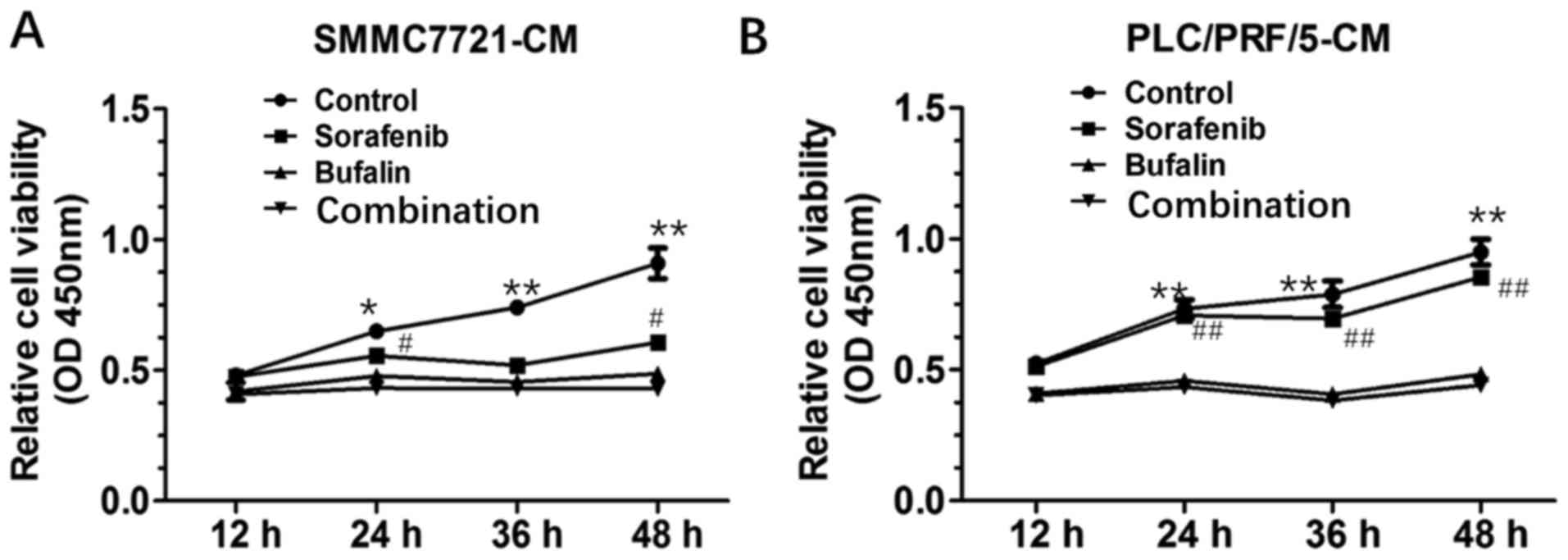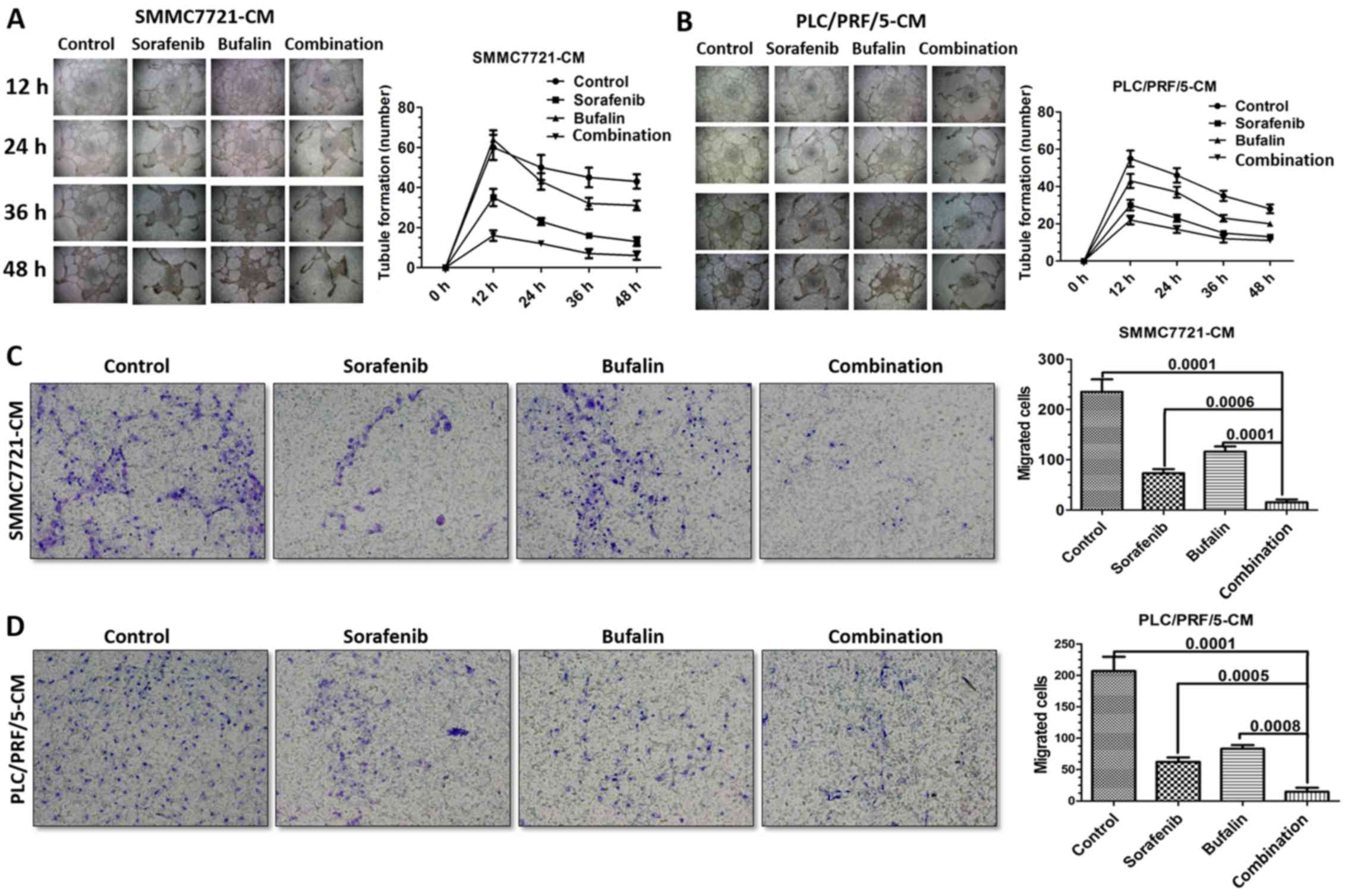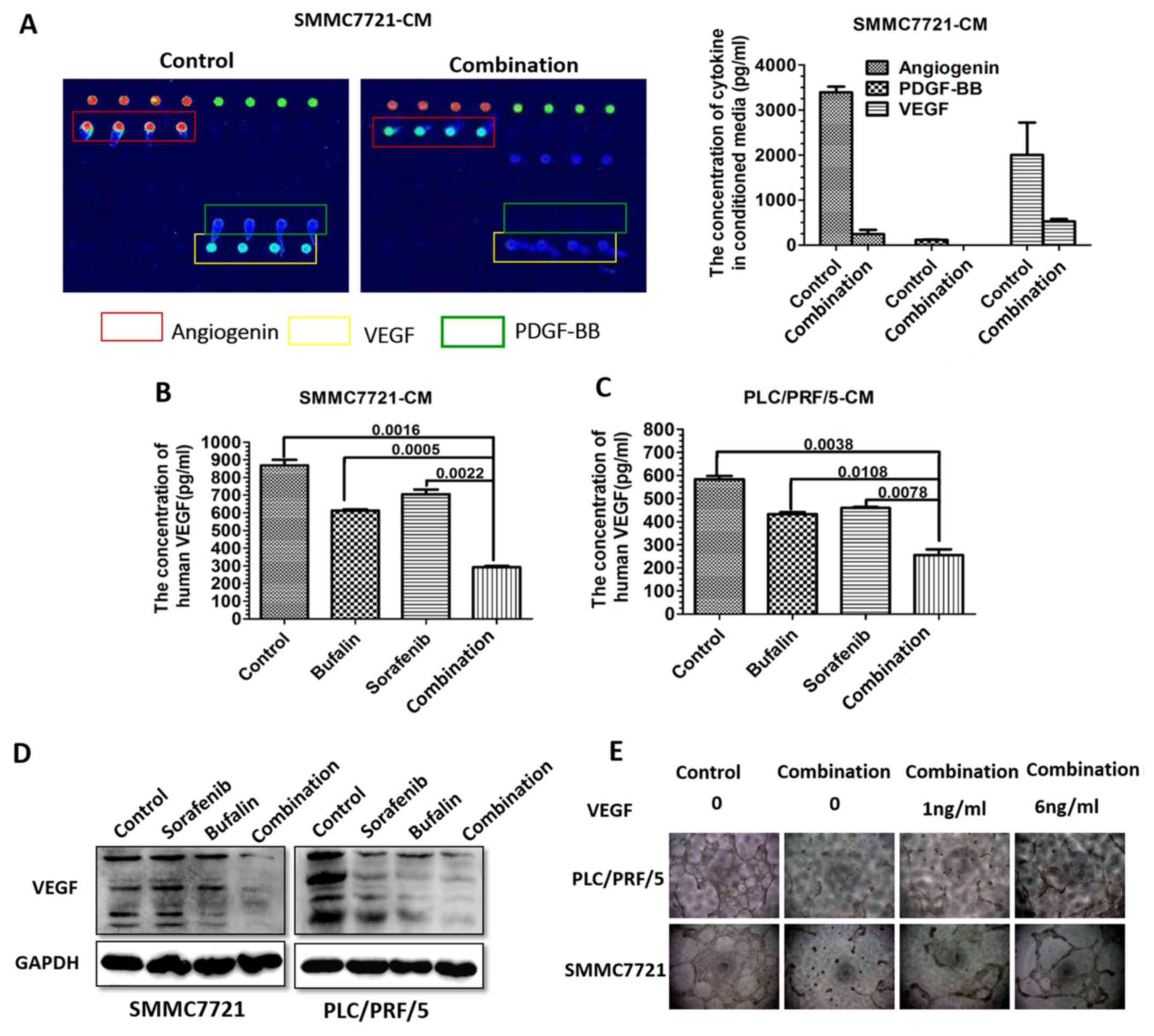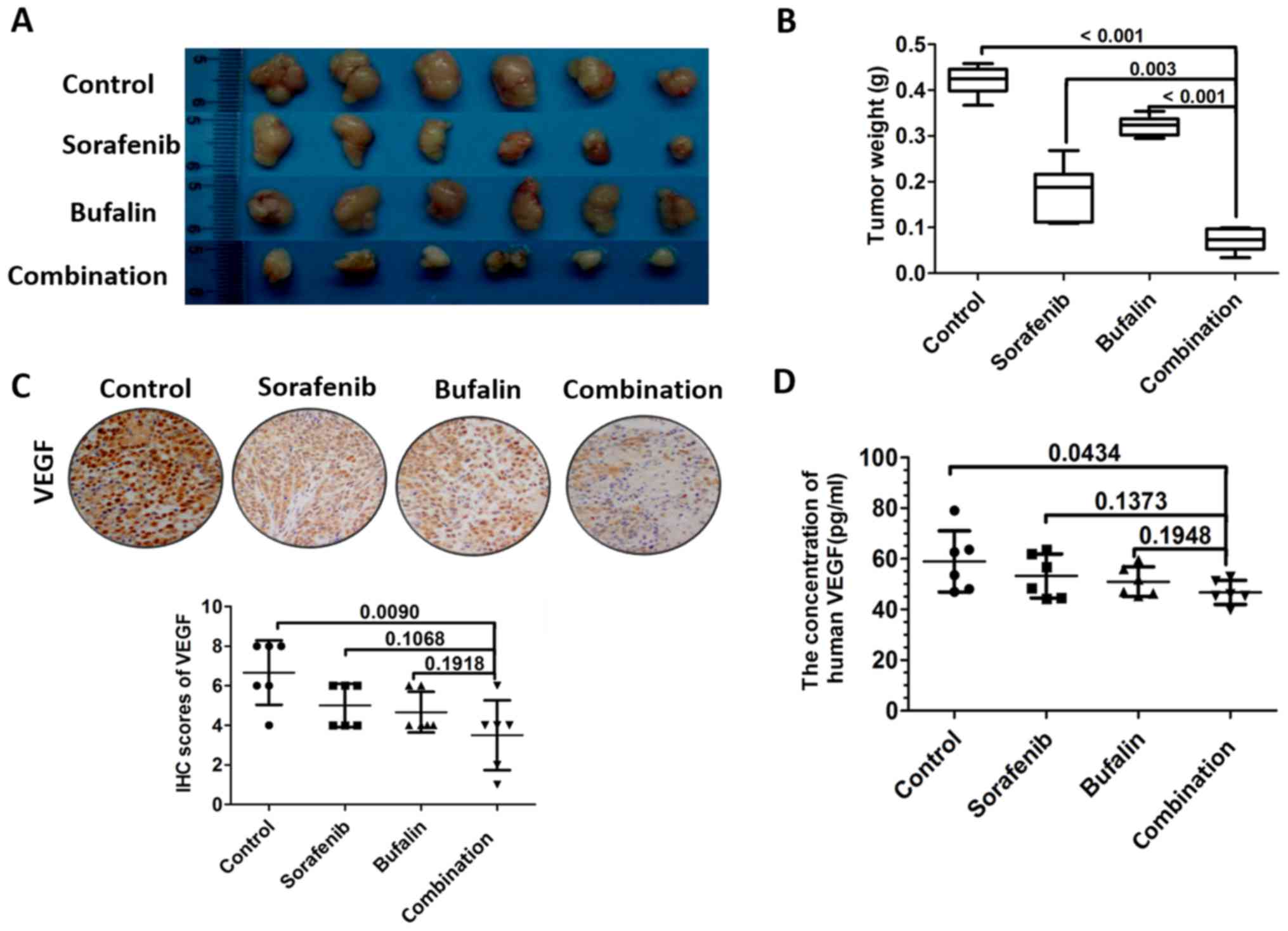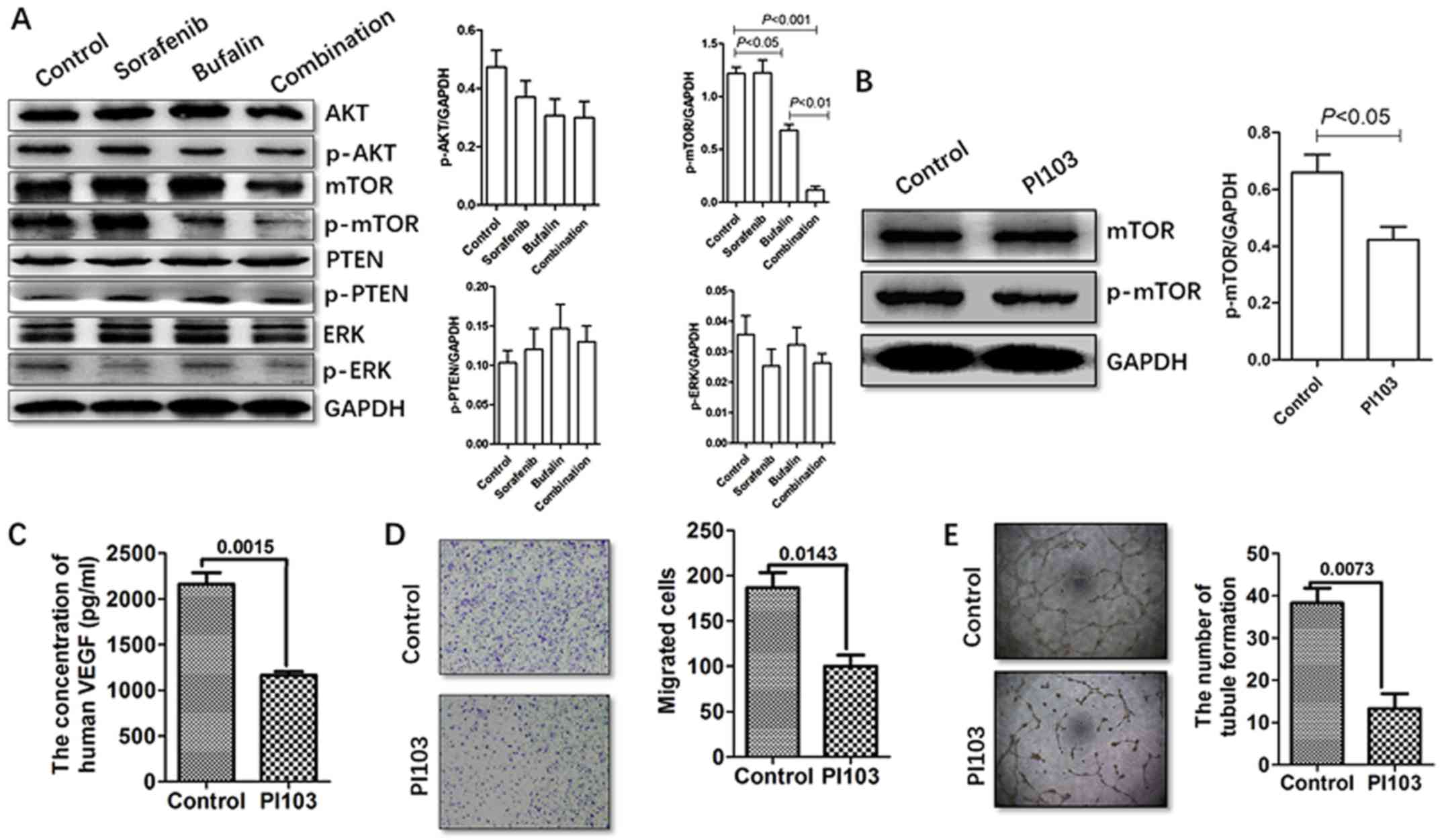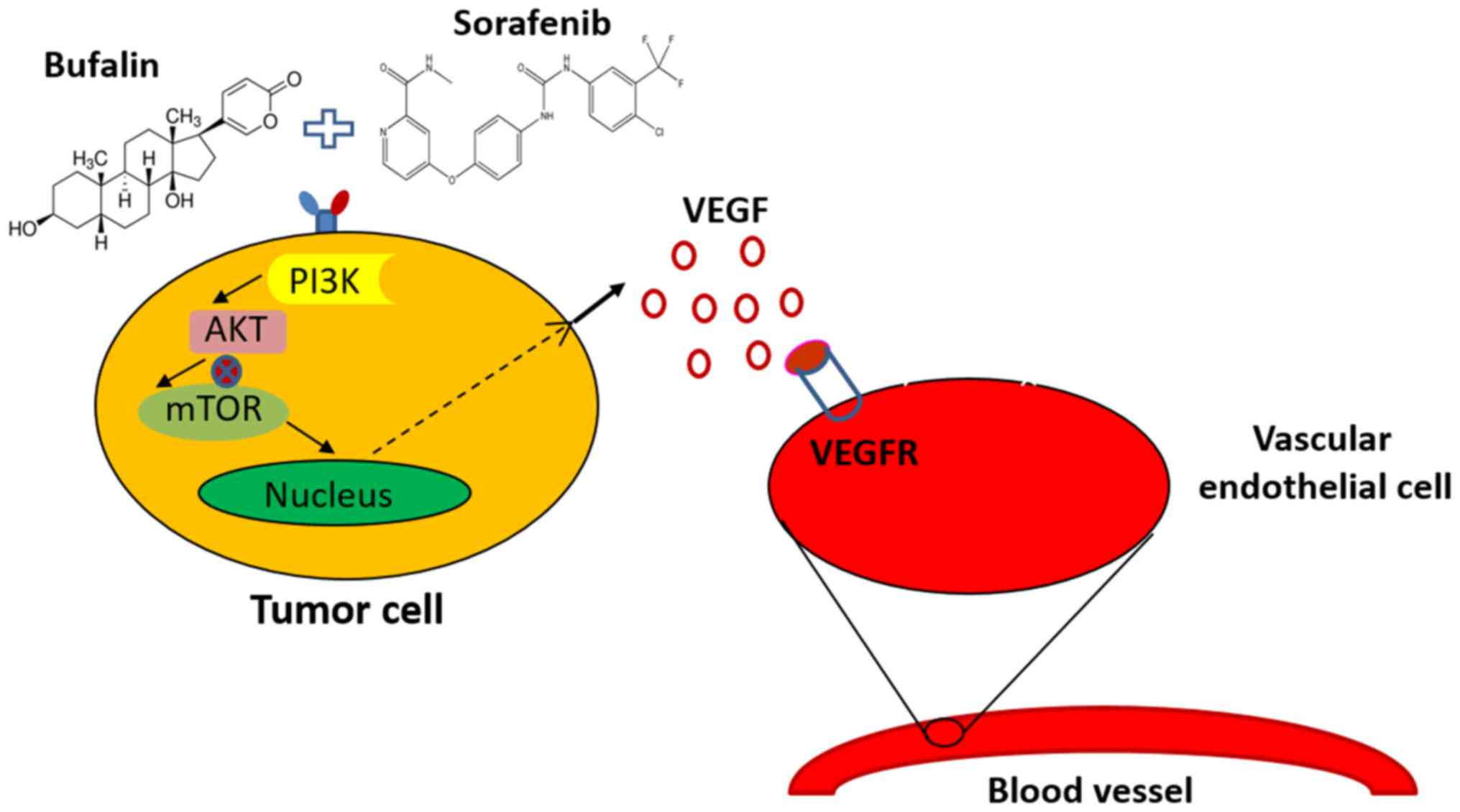Synergistic anti-hepatoma effect of bufalin combined with sorafenib via mediating the tumor vascular microenvironment by targeting mTOR/VEGF signaling
- Authors:
- Published online on: April 2, 2018 https://doi.org/10.3892/ijo.2018.4351
- Pages: 2051-2060
Abstract
Introduction
Hepatocellular carcinoma (HCC) has been identified as a highly vascularized tumor (1,2). Therefore, an effective option for the treatment of HCC is to suppress angiogenesis, as has been widely recognized and utilized by oncologists worldwide (3,4). There have been numerous studies on tumor angiogenesis in previous years. For example, studies have revealed that the major cytokines responsible for tumor angiogenesis are secreted via the intricate interaction between tumor cells and stromal cells (5,6). Among these factors, vascular endothelial growth factor (VEGF) is pivotal as the primary molecular driver in vasculogenesis (7). Inflammatory and tumor cells secrete VEGF, which binds and activates the VEGF receptor (VRGFR) on the surface of endothelial cells (ECs), stimulating various signaling pathways to accelerate angiogenesis (8–10). Therefore, the inhibition of tumor angiogenesis via the suppression of VEGF is favorably recommended by clinicians globally.
Sorafenib, a tyrosine kinase inhibitor, is recommended and widely used for patients with advanced HCC (11–13). However, its therapeutic effect in HCC is limited. Although it has been demonstrated to increase overall survival rates in patients with advanced stage HCC, the response rate is low, as resistance to and intolerance of sorafenib are common. It has been reported that pregnane X and proliferation and apoptosis adaptor protein 15 mediate sorafenib resistance (14,15). Therefore, a combination of sorafenib with other treatment modalities may be advantageous.
Bufalin, the major bioactive component isolated from toad venom, has been confirmed as a potent antitumor drug through its effect on tumor cell proliferation, apoptosis and migration (16–18). In our previous study, it was demonstrated that the antiangiogenic effect of sorafenib was markedly improved by combination with bufalin via targeting AKT/VEGF in human umbilical vein endothelial cells (HUVECs) and HCC cells (19). Bufalin was also demonstrated to suppress HCC metastasis via hypoxia inducible factor/VEGF signaling (20). Others reported the inhibitory effect of bufalin on HCC cell proliferation (21,22). However, whether the synergistic effect of bufalin combined with sorafenib is achieved in HCC cells by targeting tumor cells and surrounding ECs remains to be elucidated, and the underlying mechanisms have not been identified. These issues were considered in the present study.
Materials and methods
Antibodies and reagents
The primary antibodies used in the present study included: VEGF (Bioworld Technology, Inc., St. Louis Park, MN, USA), phosphorylated AKT (p-AKT), p-mechanistic target of rapamycin (p-mTOR), p-phosphatase and tensin homolog (p-PTEN), p-extracellular signal-regulated kinase (p-ERK1/2), and AKT, mTOR, PTEN, ERK and GAPDH (Cell Signaling Technology, Inc., Danvers, MA, USA). The reagents used in the present study included: PI103 (Selleck Chemicals, Houston, TX, USA), the Human Angiogenesis Array Q1 (RayBiotech, Norcross, GA, USA), sorafenib (Selleck Chemicals) and bufalin (Sigma-Aldrich; Merck KGaA, Darmstadt, Germany)
Cell lines
The in vitro experiments were performed with HUVECs from the American Type Culture Collection (Manassas, VA, USA), and SMMC-7721 and PLC/PRF/5 HCC cells, which were purchased from the Cell Bank of Type Culture Collection of Chinese Academy of Sciences (Shanghai, China). The cells were propagated with DMEM containing 10% fetal bovine serum (FBS; HyClone, GE Healthcare Life Sciences, Logan, UT, USA) and 1% penicillin/streptomycin at 37°C in an atmosphere containing 5% CO2.
Animals
Six-week old male Balb/c nude mice were used in the present study. The study was approved by Fudan University Shanghai Cancer Center (Shanghai, China). The mice were purchased from Vital River Laboratory Animal Technology Co., Ltd. (Beijing, China), and were raised under the following pathogen-free conditions: Room temperature, 20°C; relative humidity, ~50%. The mice were given ad libitum access to food and water, and received humane care according to the principles of animal care of Fudan University (Shanghai, China). The mice were maintained under a 12-h light/dark cycle. The principles were as described in the Guide for the Care and Use of Laboratory Animals issued by the National Institutes of Health (Bethesda, MD, USA). The mice were randomly divided into four groups (n=6 mice/group). The mice in the experimental group were intraperitoneally injected with 1 mg/kg bufalin (5 days/week), oral uptake of 30 mg/kg/day sorafenib (5 days/week), or combination treatment with the two drugs. The control mice were treated with the vehicle only. The treatment lasted for 16 days, following which the mice were sacrificed, and the tumors and blood were obtained. All experiments conformed to the ethical principles of animal experimentation stipulated by Fudan University.
In vivo tumorigenicity assay
A total of 5×106 SMMC-7721 cells in 0.2 ml phosphate-buffered saline (PBS) were injected into the right flank of each mouse to form subcutaneous tumors. When the volume of these subcutaneous tumors reached a size of 100–300 mm3, the mice were treated with intraperitoneal injections of mg/kg bufalin (5 days/week), 30 mg/kg oral sorafenib (5 days/week), or a combination of the two drugs. The control mice were treated with saline. Tumor size was measured every 4 days. The tumor-bearing mice were sacrificed following 16 days of treatments, and tumors and blood were extracted. The tumors were weighed and subjected to immunohistochemistry. All procedures conformed to the ethical principles of animal experimentation as stipulated by Fudan University.
Cell viability assay
To evaluate the effects of different treatments on cell viability, the HCC cells and HUVECs were plated in 96-well plates at a density of 5,000 cells per well. A total of 20 nM bufalin, 10 μM sorafenib, or a combination of the two were added to the wells and incubated at 37°C for 24, 48 or 72 h. The cells were subjected to a Cell Counting Kit-8 assay (Dojindo Molecular Technologies, Inc., Kumamoto, Japan), used according to the manufacturer’s protocol, and the absorbance was measured at a wavelength of 450 nm with a microplate reader to determine the cell viability rate.
Cell migration assay
To determine the effects of sorafenib, bufalin, or a combination of the two on cell migration, an assay was performed using Transwell inserts (8-μm pore; Corning Incorporated, Corning, NY, USA). The lower side of the chamber was filled with condition medium (CM) from the HCC cell lines (SMMC-7721 and PLC/PRF/5) following different treatments (control, bufalin, sorafenib, and combination). The HUVEC cells were plated on the upper side of the chamber. Following a 48-h incubation period, the migrated cells were fixed with methanol and stained with 0.1% crystal violet. The numbers of migrated cells were calculated in three different fields of view, at ×20 magnification using an Olympus light microscope (Olympus Corporation, Tokyo, Japan).
Collection of CM
The SMMC7721 and PLC/PRF/5 cells were treated with bufalin, sorafenib, or the two in combination. At 48 h post-treatment, the cell supernatants were collected as CM. The collected CM from each group was stored at −80°C if not used immediately and was thawed prior to use.
Tube formation assay
A 96-well plate was coated with Matrigel and HUVEC cells were seeded at density of 4×104 cells per well in 100 μl CM, with or without 1 or 6 ng/ml VEGF. The HUVECs were then incubated at 37°C for 12, 24, 36 or 48 h. The central region of each well and the tube networks were analyzed using an Olympus light microscope (Olympus Corporation).
Detection of cytokines associated with angiogenesis using the human angiogenesis array kit
To determine the cytokines in SMMC-7721 cells treated with bufalin, sorafenib, or the two in combination, the Human Angiogenesis Array Q1 kit was used to detect angiogenesis-related cytokines in the CM extracted from HCC cells in the different treatment groups, according to the kit protocol. Following this, the VEGF concentration was determined using an enzyme-linked immunosorbent assay (ELISA) kit, according to the manufacturer’s protocol and analyzed using a Labsystems Multiscan reader (Thermo Fisher Scientific, Inc., Waltham, MA, USA).
Western blot analysis
Western blot analysis was performed as previously described (23). Briefly, proteins were extracted from cells following the indicated treatments using radioimmunoprecipitation assay buffer (R0020; Beijing Solarbio, Science & Technology Co., Ltd., Beijing, China). Protein concentrations were assessed using a bicinchoninic acid kit. Subsequently, protein samples (12 μg) were loaded and separated by 10% SDS-PAGE for the detection of various proteins. Proteins were then transferred to polyvinylidene fluoride membranes, which were blocked in 5% skim milk for 1 h at 37°C. The expression levels of VEGF, AKT, p-AKT, mTOR, pmTOR, PTEN and p-PTEN were detected by incubation with their respective primary antibodies overnight at 4°C, after which the blots were washed three times with PBS. The primary antibodies used in the present study included: VEGF (20301555-1, 1:1,000; Bioworld Technology, Inc.), phosphorylated AKT (p-AKT; 4060, 1:2,000), p-mechanistic target of rapamycin (p-TOR; 5536, 1:1,000), p-phosphatase and tensin homolog (p-PTEN; 9551, 1:1,000), p-extracellular signal-regulated kinase (p-ERK; 4370, 1:2,000), and AKT (4691, 1:1,000), m-TOR (2983, 1:1,000), PTEN (9188, 1:1,000), ERK (9102, 1:1,000) and GAPDH (5174, 1:1,000) (all from Cell Signaling Technology, Inc.). Finally, the blots were incubated with a horseradish peroxidase-conjugated immunoglobulin G secondary antibody (HAF008, 1:5,000; Novus Biologicals, LLC, Littleton, CO, USA) for 1 h at 37°C, after which proteins were visualized by enhanced chemiluminescence (WBKLS0500; Merck KGaA). Semi-quantification of the blots was conducted using ImageJ software (version no. k 1.45; National Institutes of Health).
ELISA
The mice were treated with the different treatments, as described above. Blood samples were collected from the eyeballs of the mice. The expression of VEGF in the blood was measured using an ELISA kit, according to the manufacturer’s protocol.
Immunohistochemistry
Immunohistochemistry protocols were performed as described previously (23). Samples were dehydrated in 70% ethanol, embedded in paraffin and sectioned (4 μm). Briefly, the tumor sections were stained with rabbit anti-VEGF (1:1,000; cat. no. AP0742; Bioworld Technology, Inc.) at 4°C overnight, followed by a goat-anti-rabbit secondary antibody (1:1,000; cat. no. 7054; Cell Signaling Technology, Inc.) for 1 h at 37°C. The expression of VEGF was calculated by multiplying the intensity score by the percentage score using an Olympus light microscope (Olympus Corporation). The staining intensity (0, negative; 1, weak; 2, intense) and the ratio of stained cells (0, ≤10%; 1, 11–25%; 2, 26–50%; 3, 51–75%; 4, >75%) were evaluated by investigators blinded to the treatment status.
Statistical analysis
The results were analyzed using SPSS 22.0 software for Windows (IBM SPSS, Armonk, NY, USA). The comparisons between two groups were made using Student’s t-test. Multi-group comparisons of the means were made using one-way analysis of variance with post hoc contrasts using the Student-Newman-Keuls test. All experiments were repeated three times. P<0.05 was considered to indicate a statistically significant difference.
Results
Combination-CM induced the most marked inhibition of HUVEC proliferation. The SMMC-7721 and PLC/PRF/5 HCC cells were treated with 10 μM sorafenib, 20 nM bufalin, or a combination of the two for 12, 24, 36 or 48 h. The CM was collected 48 h following treatment. The HUVECs were subjected to CM from the HCC cells in the different treatment groups, and the proliferation of the HUVECs was evaluated. A CCK8 assay was used to determine whether a synergistic effect was present in the combination-treated HUVEC. The combination-CM led to a decrease in HUVEC proliferation from 24 h, compared with that in the control-CM, bufalin-treated CM and sorafenib-treated CM. The effect of the combination-CM on HUVECs was most marked at 48 h post-incubation, compared with the control-CM and sorafenib-treated CM (Fig. 1).
Combination-treated CM inhibits HUVEC tube formation and migration
The SMMC-7721 and PLC/PRF/5 cells were incubated with 10 μM sorafenib, 20 nM bufalin, or a combination of the two. At 12, 24, 36 and 48 h post-treatment, the CM was collected and incubated with HUVECs. A tube formation assay was performed to observe the effect of the treatments. It was observed that the combination-CM inhibited the blood vessel formation of the HUVECs most markedly, compared with the other groups (Fig. 2A and B). The migration rates of the HUVECs in the different treatments groups were also detected. The migration rate of the HUVECs treated with the combination-CM was reduced compared with that of the HUVECs in the other treatment groups for the SMMC-7721 and PLC/PRF/5 cells (Fig. 2C and D).
Expression of VEGF is significantly reduced in combination-CM-treated HCC cells in vitro
As it was previously identified that combination-CM-treated HUVECs exhibited reduced blood vessel formation and inhibit migration, it was hypothesized that the expression of cytokines associated with angiogenesis may be altered in the CM from the combination-treated SMMC-7721 cells. Therefore, the CM from the untreated and combination-CM-treated SMMC-7721 cells was analyzed using an angiogenesis-specific array for cytokine detection. Angiogenin, platelet-derived growth factor (PDGF-BB) and VEGF were altered most of the cytokines assessed, indicative of a potential role in facilitating angiogenesis (Fig. 3A). To further validate the alterations in cytokine expression detected by the human angiogenesis array, the concentration of VEGF was measured in the CM from SMMC-7721 and PLC/PRF/5 cells in the different treatment groups using ELISA (Fig. 3B and C). The results of the western blot analysis confirmed the ELISA results for the SMMC-7721 and PLC/PRF/5 cells (Fig. 3D).
CM from the SMMC7721 and PLC/PRF/5 cells collected at 48 h was added to HUVECs with or without the addition of 1 or 6 ng/ml VEGF, and tube formation was observed. The combination-CM suppressed HUVEC vessel formation. The incubation of HUVECs with VEGF disrupted the inhibitory effect on tubule formation induced by the addition of combination-CM. The higher concentration of VEGF resulted in enhanced vessel formation (Fig. 3E).
Combination treatment inhibits the secretion of VEGF in vivo
To measure the effect of the combination treatment on tumor growth in vivo, a subcutaneous tumor model was established. Mice received 1 mg/kg/day bufalin, 30 mg/kg/day sorafenib, or a combination of the two for 16 days. The tumors were then excised and weighed. The results revealed that the subcutaneous tumors from mice that received the combination treatment were smaller, compared with those in the other groups (Fig. 4A). The tumor weights were significantly attenuated in mice that received the combination treatment, compared with those treated with bufalin or sorafenib alone (Fig. 4B). Further analyses of the expression of VEGF in tumors revealed that the expression of VEGF was lowest in the tumors and blood from mice that received the combination treatment, as determined with immunohistochemistry and ELISA (Fig. 4C and D).
Combination treatment affects HCC cells via the mTOR/VEGF pathway
As it was identified that a decrease in the expression of VEGF occurred due to the combined treatment and that this may reduce the extent of angiogenesis in HCC, the pathways associated with VEGF were examined. The proteins upstream of VEGF were measured in HCC cells in the different treatments groups, including the phosphorylated and total levels of AKT, mTOR, PTEN and ERK, with western blot analysis. The HCC cells incubated with either bufalin or the combination treatment demonstrated a marginal decrease in the expression of p-AKT. The expression of p-mTOR was also reduced in the HCC cells incubated with bufalin or the combination treatment. However, no significant alterations were identified in the phosphorylation of PTEN or ERK (Fig. 5A).
As a decrease was observed in the expression of p-AKT and p-mTOR in the combination-treated SMMC-7721 cells, their involvement in the combination-induced reduction of VEGF was examined. PI103 (2 μM) was selected as a specific pharmacological inhibitor of the phosphoinositide 3-kinase (PI3K)/AKT/mTOR pathway. The results demonstrated that pretreatment with PI103 partially reversed the phosphorylation of mTOR (Fig. 5B). It was also observed that the expression of VEGF was significantly downregulated in the HCC cells pretreated with PI103, indicating the potential role of the mTOR pathway in modulating VEGF (Fig. 5C). The present study also evaluated the effect of the CM from cells pretreated with PI103 on HUVEC migration and tube formation. Compared with the CM from the non-pretreated cells, HUVEC migration and tube formation were suppressed by pretreatment with PI103 (Fig. 5D and E). Collectively, these results demonstrated that the mTOR pathway was involved in the reduced expression of VEGF induced by combination treatment.
Proposed mechanism by which bufalin augments the sorafenib-induced inhibition of angiogenesis through the mTOR/VEGF signaling pathway in HCC
The present study identified bufalin as asynergistic agent for HCC cells treated with sorafenib by regulating the mTOR/VEGF pathway, leading to the reduced secretion of VEGF. The reduced binding of VEGF to VEGFR on the HUVECs led to reduced tumor angiogenesis. To the best of our knowledge, this is the first evidence of the synergistic anti-hepatoma effect of bufalin combined with sorafenib via the tumor vascular microenvironment by targeting mTOR/VEGF signaling (Fig. 6).
Discussion
Angiogenesis has been reported to be intrinsically linked with tumor growth, metastasis and development. Therefore, anti-angiogenic cancer therapies have received much attention and have progressed rapidly (2,24–27). As HCC is a highly vascularized tumor, inhibition of its angiogenesis by multiple drugs is considered a promising approach with therapeutic value.
Increasing evidence is available regarding the antitumor effect of bufalin on tumor cells. It has been reported to suppress proliferation and migration, and induce apoptosis in tumor cells (19–21). However, there are relatively few reports regarding the effect of bufalin on ECs. In our previous study, it was demonstrated that the synergistic effect of bufalin with sorafenib may be due to inhibition of the AKT/VEGF signaling pathway in HUVECs (22). Given the inhibitory effect of bufalin treatment on tumor cells and the established interactions between tumor cells and ECs, it was hypothesized that the synergistic role of bufalin with sorafenib may be partly explained by alterations to the cytokines in the tumor microenvironment, which affect the angiogenesis and migration of ECs.
To determine the effect of the combined treatment on HCC proliferation, two HCC cell lines (SMMC-7721 and PLC/PRF/5) were used. The proliferation assay demonstrated that HCC cell viability was significantly reduced in HCC cells exposed to the combined treatment, compared with those treated with sorafenib alone. To test the hypothesis described above, CM from HCC cells in each of the different treatment groups was collected at 24 h post-incubation, and cultured with HUVECs for 12, 24, 36 or 48 h. As described in the results, the HUVECs incubated with the combination-CM underwent the least tube formation, suggesting there may be either less pro-angiogenic or more antiangiogenic cytokines produced by the HCC cells exposed to combination treatment. Furthermore, the number of migrated HUVECs was lowest following treatment with the combination-CM, as determined by a Transwell migration assay, which may be reflective of a metastasis-suppressive effect of the combined treatment. These results were in accord, highlighting the dual properties of combined treatment in the inhibition of endothelial angiogenesis and metastasis.
Subsequently, the present study aimed to ascertain the mechanisms that led to the attenuation of angiogenesis and metastasis in the HUVECs. Therefore, a human angiogenesis array was adopted. The results demonstrated that VEGF, PDGF-BB and angiogenin were the cytokines with the most marked significant alteration between the control cells and the cells exposed to the combined treatment. Of the three most altered cytokines, VEGF has been investigated most for its potent pro-angiogenic properties. VEGF initiates signaling pathways in ECs to promote proliferation, migration, survival and vascular permeability. VEGF inhibitors have been developed, as the overexpression of VEGF is frequently associated with a poorer prognosis in various types of cancer (28,29). Subsequent ELISA and western blot analyses also confirmed the cytokine changes reported in the human angiogenesis array. To further corroborate that the inhibitory effect of combined treatment on the secretion of VEGF mediated the effect on angiogenesis, the HUVECs in the different treatment groups were treated with VEGF. The extent of vessel sprouting in the combination treatment HUVEC group was significantly reduced, which was reversed by incubation with VEGF. Therefore, the hypothesis was confirmed and validated.
The present study is notable as it focused not only on tumor cells, but also on ECs. The tumor microenvironment is a popular focus of investigations; the crosstalk between ECs and HCC cells can affect angiogenesis and metastasis via the regulation of inflammatory cytokines (30–32). The present study observed that the combination-CM derived from HCC cells attenuated angiogenesis and metastasis, indicating the potential of the drug combination in reducing the secretion of angiogenic cytokines.
In addition, in vivo experiments were performed to analyze the combined effect of bufalin and sorafenib. The expression of VEGF was reduced in the subcutaneous tumors and serum of mice receiving the combined treatment, compared with that in the mice receiving the drugs individually, as demonstrated by immunohistochemistry and ELISA. These results further demonstrated the synergistic role of bufalin and sorafenib in tumor inhibition via the suppression of VEGF.
There are numerous pathways involved in angiogenesis. For example, PI3K/AKT, PTEN/AKT, AKT/mTOR and mitogen-activated protein kinase kinase/ERK have all been associated with tumor angiogenesis via the upregulation of VEGF (33–36). Previous studies have demonstrated that the VEGF/PI3K/AKT pathway is associated with Nogo-B-induced angiogenesis in primary human retinal ECs (37). VEGF activates PI3K, which triggers the phosphorylation of AKT, leading to increased endothelial nitric oxide synthase activity. PI3K/AKT/mTOR is a pivotal signaling pathway responsible for cell proliferation, metabolism and motility (38,39). Previous studies have also confirmed its involvement in angiogenesis (40,41).
The present study determined the relative expression of the main proteins involved in the PI3K/AKT, PTEN/AKT, AKT/mTOR and MEK/ERK pathways. The results demonstrated that the level of p-AKT was significantly altered in the HCC cells that received the combined treatment, compared with that in the HCC cells treated with sorafenib alone. The level of p-m-TOR was decreased in the combination treatment group, compared with that in the SMMC-7721 cells treated with sorafenib. To further validate the role of the PI3K/AKT pathway in the altered expression of mTOR, the PI3K inhibitor PI103 was used. Incubation of the HCC cells with P1103 led to a marginal reduction of p-mTOR, whereas the application of PI103 led to a significant reduction in the expression of VEGF, reflecting the role of PI3K/AKT in the secretion of VEGF. This was also demonstrated in the migration and tube formation assays.
However, there were a number of limitations in the present study. First, the antiangiogenic effect of the combined drug was a comprehensive result of the balance between the production of fewer proangiogenic factors or increased secretion of antiangiogenic factors. There may be several other cytokine changes in the combination-treated CM, compared with the mono-drug-treated CM in addition to VEGF, however, the present study focused on VEGF only. Investigations are required to ascertain other angiogenic factor changes induced by the combination treatment in the future. Second, additional in vivo experiments are required to confirm the synergistic anti-hepatoma effect of the combined treatment of sorafenib and bufalin via mediating the tumor vascular microenvironment by targeting mTOR/VEGF signaling.
In conclusion, the present study identified bufalin as a synergistic agent for HCC treated with sorafenib by regulating tumor cells and ECs. The combined treatment affected HCC cells via the mTOR/VEGF pathway, leading to the reduced secretion of VEGF. The decreased secretion of VEGF produced by SMMC-7721 cells resulted in reduced migration and tube formation in HUVECs. Therefore, the mTOR/VEGF pathway may be one of the targets accounting for the enhanced effect of sorafenib treatment with bufalin.
Acknowledgments
Not applicable.
Funding
The present study was supported by the National Natural Science Foundation of China (grant nos. 81573753 and 81603348), the China Postdoctoral Fund (grant no. 21300075311104) and the Shandong Postdoctoral Innovation Special Fund (grant no. 201602012).
Availability of data and materials
All data generated or analyzed during this study are included in this published article.
Authors’ contributions
HW performed the in vivo studies and designed the study. CZ performed the in vitro studies and wrote the original manuscript. HC conducted the western blot experiments and analysed the data. ZM designed the study and reviewed the article.
Ethics approval and consent to participate
The study was approved by Fudan University Shanghai Cancer Center and all experiments conformed to the ethical principles of animal experimentation stipulated by Fudan University. The principles were as described in the Guide for the Care and Use of Laboratory Animals issued by the National Institutes of Health.
Consent for publication
Not applicable.
Competing interests
The authors declare that there are no competing interests.
References
|
Borzio M, Dionigi E, Parisi G, Raguzzi I and Sacco R: Management of hepatocellular carcinoma in the elderly. World J Hepatol. 7:1521–1529. 2015. View Article : Google Scholar | |
|
Folkman J: Tumor angiogenesis: Therapeutic implications. N Engl J Med. 285:1182–1186. 1971. View Article : Google Scholar | |
|
Folkman J: Anti-angiogenesis: New concept for therapy of solid tumors. Ann Surg. 175:409–416. 1972. View Article : Google Scholar | |
|
Folkman J: Role of angiogenesis in tumor growth and metastasis. Semin Oncol. 29(Suppl 16): 15–18. 2002. View Article : Google Scholar | |
|
Portillo-Lara R and Annabi N: Microengineered cancer-on-a-chip platforms to study the metastatic microenvironment. Lab Chip. 16:4063–4081. 2016. View Article : Google Scholar | |
|
Maj E, Papiernik D and Wietrzyk J: Antiangiogenic cancer treatment: The great discovery and greater complexity (Review). Int J Oncol. 49:1773–1784. 2016. View Article : Google Scholar | |
|
Yang Y, Zhang Y, Iwamoto H, Hosaka K, Seki T, Andersson P, Lim S, Fischer C, Nakamura M, Abe M, et al: Discontinuation of anti-VEGF cancer therapy promotes metastasis through a liver revascularization mechanism. Nat Commun. 7:126802016. View Article : Google Scholar | |
|
Falchook GS, Moulder S, Naing A, Wheler JJ, Hong DS, Piha-Paul SA, Tsimberidou AM, Fu S, Zinner R, Janku F, et al: A phase I trial of combination trastuzumab, lapatinib, and bevacizumab in patients with advanced cancer. Invest New Drugs. 33:177–186. 2015. View Article : Google Scholar | |
|
Fan X, Krieg S, Kuo CJ, Wiegand SJ, Rabinovitch M, Druzin ML, Brenner RM, Giudice LC and Nayak NR: VEGF blockade inhibits angiogenesis and reepithelialization of endometrium. FASEB J. 22:3571–3580. 2008. View Article : Google Scholar | |
|
Hong DS, Garrido-Laguna I, Ekmekcioglu S, Falchook GS, Naing A, Wheler JJ, Fu S, Moulder SL, Piha-Paul S, Tsimberidou AM, et al: Dual inhibition of the vascular endothelial growth factor pathway: A phase 1 trial evaluating bevacizumab and AZD2171 (cediranib) in patients with advanced solid tumors. Cancer. 120:2164–2173. 2014. View Article : Google Scholar | |
|
Liu L, Cao Y, Chen C, Zhang X, McNabola A, Wilkie D, Wilhelm S, Lynch M and Carter C: Sorafenib blocks the RAF/MEK/ERK pathway, inhibits tumor angiogenesis, and induces tumor cell apoptosis in hepatocellular carcinoma model PLC/PRF/5. Cancer Res. 66:11851–11858. 2006. View Article : Google Scholar | |
|
Pressiani T, Boni C, Rimassa L, Labianca R, Fagiuoli S, Salvagni S, Ferrari D, Cortesi E, Porta C, Mucciarini C, et al: Sorafenib in patients with Child-Pugh class A and B advanced hepatocellular carcinoma: A prospective feasibility analysis. Ann Oncol. 24:406–411. 2013. View Article : Google Scholar | |
|
Sposito C, Mariani L, Germini A, Flores Reyes M, Bongini M, Grossi G, Bhoori S and Mazzaferro V: Comparative efficacy of sorafenib versus best supportive care in recurrent hepatocellular carcinoma after liver transplantation: A case-control study. J Hepatol. 59:59–66. 2013. View Article : Google Scholar | |
|
Feng F, Jiang Q, Cao S, Cao Y, Li R, Shen L, Zhu H, Wang T, Sun L, Liang E, et al: Pregnane X receptor mediates sorafenib resistance in advanced hepatocellular carcinoma. Biochim Biophys Acta. 1862:1017–1030. 2018. View Article : Google Scholar | |
|
Quintavalle C, Hindupur SK, Quagliata L, Pallante P, Nigro C, Condorelli G, Andersen JB, Tagscherer KE, Roth W, Beguinot F, et al: Phosphoprotein enriched in diabetes (PED/PEA15) promotes migration in hepatocellular carcinoma and confers resistance to sorafenib. Cell Death Dis. 8:e31382017. View Article : Google Scholar | |
|
Takai N, Ueda T, Nishida M, Nasu K and Narahara H: Bufalin induces growth inhibition, cell cycle arrest and apoptosis in human endometrial and ovarian cancer cells. Int J Mol Med. 21:637–643. 2008. | |
|
Huang WW, Yang JS, Pai SJ, Wu PP, Chang SJ, Chueh FS, Fan MJ, Chiou SM, Kuo HM, Yeh CC, et al: Bufalin induces G0/G1 phase arrest through inhibiting the levels of cyclin D, cyclin E, CDK2 and CDK4, and triggers apoptosis via mitochondrial signaling pathway in T24 human bladder cancer cells. Mutat Res. 732:26–33. 2012. View Article : Google Scholar | |
|
Yin JQ, Shen JN, Su WW, Wang J, Huang G, Jin S, Guo QC, Zou CY, Li HM and Li FB: Bufalin induces apoptosis in human osteosarcoma U-2OS and U-2OS methotrexate300-resistant cell lines. Acta Pharmacol Sin. 28:712–720. 2007. View Article : Google Scholar | |
|
Wang H, Zhang C, Ning Z, Xu L, Zhu X and Meng Z: Bufalin enhances anti-angiogenic effect of sorafenib via AKT/VEGF signaling. Int J Oncol. 48:1229–1241. 2016. View Article : Google Scholar | |
|
Wang H, Zhang C, Xu L, Zang K, Ning Z, Jiang F, Chi H, Zhu X and Meng Z: Bufalin suppresses hepatocellular carcinoma invasion and metastasis by targeting HIF-1α via the PI3K/AKT/mTOR pathway. Oncotarget. 7:20193–20208. 2016. | |
|
Qiu DZ, Zhang ZJ, Wu WZ and Yang YK: Bufalin, a component in Chansu, inhibits proliferation and invasion of hepatocellular carcinoma cells. BMC Complement Altern Med. 13:1852013. View Article : Google Scholar | |
|
Gao Y, Li HX, Xu LT, Wang P, Xu LY, Cohen L, Yang PY, Gu K and Meng ZQ: Bufalin enhances the anti-proliferative effect of sorafenib on human hepatocellular carcinoma cells through downregulation of ERK. Mol Biol Rep. 39:1683–1689. 2012. View Article : Google Scholar | |
|
Zhuang L, Xu L, Wang P, Jiang Y, Yong P, Zhang C, Zhang H, Meng Z and Yang P: Na+/K+-ATPase α1 subunit, a novel therapeutic target for hepatocellular carcinoma. Oncotarget. 6:28183–28193. 2015. | |
|
Butler JM, Kobayashi H and Rafii S: Instructive role of the vascular niche in promoting tumour growth and tissue repair by angiocrine factors. Nat Rev Cancer. 10:138–146. 2010. View Article : Google Scholar | |
|
Kerbel RS: Tumor angiogenesis. N Engl J Med. 358:2039–2049. 2008. View Article : Google Scholar | |
|
Ferrara N and Kerbel RS: Angiogenesis as a therapeutic target. Nature. 438:967–974. 2005. View Article : Google Scholar | |
|
Bridges EM and Harris AL: The angiogenic process as a therapeutic target in cancer. Biochem Pharmacol. 81:1183–1191. 2011. View Article : Google Scholar | |
|
Fu L, Shi K, Wang J, Chen W, Shi D, Tian Y, Guo W, Yu W, Xiao X, Kang T, et al: TFAP2B overexpression contributes to tumor growth and a poor prognosis of human lung adenocarcinoma through modulation of ERK and VEGF/PEDF signaling. Mol Cancer. 13:892014. View Article : Google Scholar | |
|
Chen C, Chi H, Min L and Junhua Z: Downregulation of guanine nucleotide-binding protein beta 1 (GNB1) is associated with worsened prognosis of clearcell renal cell carcinoma and is related to VEGF signaling pathway. J BUON. 22:1441–1446. 2017. | |
|
Neiva KG, Zhang Z, Miyazawa M, Warner KA, Karl E and Nör JE: Cross talk initiated by endothelial cells enhances migration and inhibits anoikis of squamous cell carcinoma cells through STAT3/Akt/ERK signaling. Neoplasia. 11:583–593. 2009. View Article : Google Scholar | |
|
Warner KA, Miyazawa M, Cordeiro MM, Love WJ, Pinsky MS, Neiva KG, Spalding AC and Nör JE: Endothelial cells enhance tumor cell invasion through a crosstalk mediated by CXC chemokine signaling. Neoplasia. 10:131–139. 2008. View Article : Google Scholar | |
|
Manzi M, Bacigalupo ML, Carabias P, Elola MT, Wolfenstein-Todel C, Rabinovich GA, Espelt MV and Troncoso MF: Galectin-1 controls the proliferation and migration of liver sinusoidal endothelial cells and their interaction with hepatocarcinoma cells. J Cell Physiol. 231:1522–1533. 2016. View Article : Google Scholar | |
|
Liu WL, Gao M, Tzen KY, Tsai CL, Hsu FM, Cheng AL and Cheng JC: Targeting phosphatidylinositide 3-kinase/Akt pathway by BKM120 for radiosensitization in hepatocellular carcinoma. Oncotarget. 5:3662–3672. 2014. View Article : Google Scholar | |
|
Paplomata E and O’Regan R: The PI3K/AKT/mTOR pathway in breast cancer: Targets, trials and biomarkers. Ther Adv Med Oncol. 6:154–166. 2014. View Article : Google Scholar | |
|
Lee MS, Jeong MH, Lee HW, Han HJ, Ko A, Hewitt SM, Kim JH, Chun KH, Chung JY, Lee C, et al: PI3K/AKT activation induces PTEN ubiquitination and destabilization accelerating tumourigenesis. Nat Commun. 6:77692015. View Article : Google Scholar | |
|
Zhang D, Li X, Yao Z, Wei C, Ning N and Li J: GABAergic signaling facilitates breast cancer metastasis by promoting ERK1/2-dependent phosphorylation. Cancer Lett. 348:100–108. 2014. View Article : Google Scholar | |
|
Zhang Y, Wang L, Zhang Y, Wang M, Sun Q, Xia F, Wang R and Liu L: Nogo-B promotes angiogenesis in proliferative diabetic retinopathy via VEGF/PI3K/Akt pathway in an autocrine manner. Cell Physiol Biochem. 43:1742–1754. 2017. View Article : Google Scholar | |
|
Philippova M, Joshi MB, Pfaff D, Kyriakakis E, Maslova K, Erne P and Resink TJ: T-cadherin attenuates insulin-dependent signalling, eNOS activation, and angiogenesis in vascular endothelial cells. Cardiovasc Res. 93:498–507. 2012. View Article : Google Scholar | |
|
Sharma S, Guru SK, Manda S, Kumar A, Mintoo MJ, Prasad VD, Sharma PR, Mondhe DM, Bharate SB and Bhushan S: A marine sponge alkaloid derivative 4-chloro fascaplysin inhibits tumor growth and VEGF mediated angiogenesis by disrupting PI3K/Akt/mTOR signaling cascade. Chem Biol Interact. 275:47–60. 2017. View Article : Google Scholar | |
|
Zhang W, Xiong Z, Wei T, Li Q, Tan Y, Ling L and Feng X: Nuclear factor 90 promotes angiogenesis by regulating HIF-1α/VEGF-A expression through the PI3K/Akt signaling pathway in human cervical cancer. Cell Death Dis. 9:2762018. View Article : Google Scholar | |
|
Song ZY, Wang F, Cui SX and Qu XJ: Knockdown of CXCR4 inhibits CXCL12-induced angiogenesis in HUVECs through downregulation of the MAPK/ERK and PI3K/AKT and the Wnt/β-catenin pathways. Cancer Invest. 36:10–18. 2018. View Article : Google Scholar |



